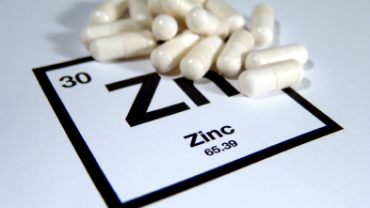
Micronutrients have nearly instantaneous associations with particular roles: there’s calcium and phosphorus for bone health; vitamin C for immune function; vitamin E for reproductive health and fertility; and iron and B12 for healthy blood and energy levels. But what about zinc? Zinc is often included in over-the-counter cold remedies but the immune system is only one mechanism that requires adequate zinc for optimal function.
Zinc is the most abundant intracellular trace element in the body and at least 300 zinc-dependent enzymes have been identified. Among them is copper/zinc superoxide dismutase (SOD) an antioxidant enzyme that protects against peroxidation of cellular lipids. While copper is responsible for the catalytic function of SOD it is zinc that provides the proper structure of the protein as part of a “zinc finger” motif which appears in many other enzymes most notably ones that regulate DNA transcription and gene expression as well as the structure of nuclear hormonal receptors for estrogen testosterone and vitamin D.
Insulin-degrading enzyme (IDE) is another zinc-dependent enzyme. Individuals with hyperinsulinemia insulin resistance and related conditions—such as type-2 diabetes metabolic syndrome and Alzheimer’s disease—should ensure adequate zinc intake to provide for proper degradation and clearance of insulin. In fact the amyloid plaques associated with Alzheimer’s are an additional substrate for IDE; nutrient deficiencies that impair the function of this enzyme should be corrected as part of the therapy.
Healthy cognitive function isn’t the only thing that may suffer as a consequence of inadequate zinc. This trace nutrient is crucial for male reproductive health. Zinc insufficiency may result in impaired testicular function and poor sperm quality and quantity. Perhaps this is why oysters have long been considered an aphrodisiac; they have a stunningly high zinc content. A single oyster—just one—provides 55% of the daily value [DV] for zinc while a 3-oz serving provides a whopping 188%. Beef and pork are also good sources of zinc. Nuts and beans/legumes are good plant sources of zinc. Pumpkin seeds are frequently cited for their zinc content and for good reason: one ounce provides 14% of the DV for zinc along with significant amounts of other important minerals such as 23% of the DV for iron 37% for magnesium 33% for phosphorus and 42% for manganese.
It’s important to note however that among plant foods with a high zinc content some of this zinc is bound to phytic acid a storage form of phosphorus that is resistant to digestion and which reduces the bioavailability of a food’s minerals. This is not usually a problem in omnivorous diets wherein other foods with zinc that is more available are consumed. But this could become a significant hindrance to the maintenance of adequate zinc levels in individuals following plant-based diets particularly if these diets are high in phytate-rich whole grains.
Absorption of zinc from foods varies from 5% to 50% depending on the source. Zinc bioavailability from plant foods is low—only about 10-15% while bioavailability of zinc from animal foods is about three to four times greater.1 The presence of phytate fiber and calcium in zinc-rich plant foods may also impair absorption.
Repletion of zinc and maintenance of adequate levels is a balancing act. Zinc intake and supplementation should be approached in the context of zinc’s interaction with other nutrients. Just as sodium and potassium intake should be in the proper ratio as well as calcium and magnesium zinc has a complex interplay with other micronutrients—in particular iron and copper. (In fact high-dose zinc supplementation has been used successfully as therapy for Wilson’s disease a condition of inappropriately high copper storage.) Very high zinc intakes can impair copper absorption. This does not typically occur from eating zinc-rich foods but uninformed supplementation can potentially bring this about. Similarly iron supplementation at high levels may impair absorption of zinc. Again not usually a problem from consuming iron-rich foods but rather with unguided supplementation.
Next time we’ll explore some of the conditions associated with zinc deficiency as this problem may be more common than is recognized in clinical practice.